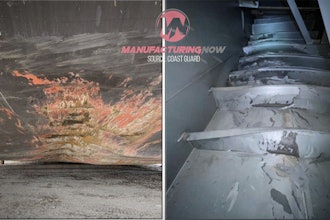Aerojet Rocketdyne recently completed work on the four RS-25 engines that will help power NASA's Space Launch System (SLS) rocket on the Artemis IV mission. Artemis IV is the ambitious plan that will see astronauts live and work in Gateway, the first lunar space station in history. The mission will help prep future human missions to Mars and will include multiple launches and spacecraft dockings in lunar orbit, including the debut of NASA's larger, more powerful SLS rocket.
Most Read on IEN:
- Toyota Subsidiary to Close its Largest U.S. Plant, Cut 1,300 Jobs
- Koenigsegg Issues Stop-Drive After $3 Million Car Bursts into Flames
- Fire at Lithium Battery Factory Kills 22
- PODCAST: Toyota Company Plant Closure; John Deere Job Cuts; e-Bike Goes 80 MPH
According to Aerojet Rocketdyne, Artemis IV will be the first flight of the enhanced Block 1B configuration of the super-heavy-lift rocket and the last to use engines remaining in inventory from the space shuttle program. The L3Harris Technologies subsidiary has modernized the engines for the mission, upgrading them with modern flight computers that can withstand higher temperatures, which is important since they will be placed next to the SLS solid rocket motors.
NASA and Aerojet recently tested the flight computers and former space shuttle main engines for the first four Artemis missions at the Stennis Space Center in Mississippi.
The first three Artemis missions will use the SLS Block 1 configuration with an interim cryogenic propulsion stage powered by a single RL10.
The upgraded SLS Block 1B rocket will have an exploration upper stage powered by four Aerojet Rocketdyne RL10 engines. Kristin Houston, president of space propulsion and power systems at Aerojet, says the 1B upgrade is a "game changer" for the "most ambitious missions ever attempted." Houston says the "new universal stage adapter above the exploration upper stage provides 24% more volume for a co-manifested payload than an industry-standard five-meter-class payload fairing."
Crewed versions of the SLS Block 1B with the exploration upper stage will be capable of delivering 38 metric tons of payload to cislunar space in a single mission—that's the area between Earth and the moon, including the moon's surface and orbit. Previous versions could only send 27 metric tons, which means 40% more payload to the moon with every crewed mission. Cargo-only versions of the vehicle can deliver some 42 metric tons.
In Artemis V, Aerojet says the SLS deep space exploration rocket will use newly manufactured versions of the RS-25 engines that take advantage of production efficiencies and advances in manufacturing to reduce unit costs by more than 30% from the shuttle versions, while also improving thrust.
According to Aerojet, the RS-25 engine has flown on 29 shuttle missions carrying 142 astronauts to orbit, more than any other set of shuttle-era engines used for Artemis.
Click here to subscribe to our daily newsletter featuring breaking manufacturing industry news.




















